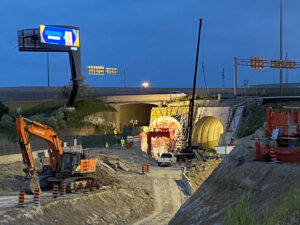Sixense monitors tunnel construction works under Highway 401 & 409
Sixense North America was retained by the Toronto Tunnel Partners (TTP) to perform environmental, geotechnical, and structural monitoring on North America’s busiest highway corridor (with 21 live lanes) throughout the construction of two new twin tunnels underneath the highways – all without disrupting the continuous traffic flow above.

We designed & deployed a monitoring system based on non-contact technologies (conventional and reflectorless robotic total stations, distance meters), horizontal shape arrays – 4DShape, as well as other structural and environmental instruments to monitor the deformation of the surface and the subgrade of the roadway, the rail tracks, and the subgrade of the rail corridor. Due to Sixense’s specialized devices, the monitoring system was able to achieve the high spatial density and high-frequency monitoring that was required on Highway 401 & 409, while in real-time minimizing interruptions of existing highway traffic and manual readings in heavy traffic areas.

After 6 months of baseline, construction was successfully completed after 2.5 years of structural improvement and excavation. The new tunnels will transform the transportation network in the Greater Toronto Area by providing a rail system that delivers two-way, all-day service every 15 minutes. The project was also recognized as the 2022 Project of the Year over $100 million by the Tunneling Association of Canada.
Some of our other tools that ensured the safety of the traveling public during the construction of this project: In-place Inclinometers, Piezometers, Tiltmeters, and Vibration & Noise Monitoring devices.
